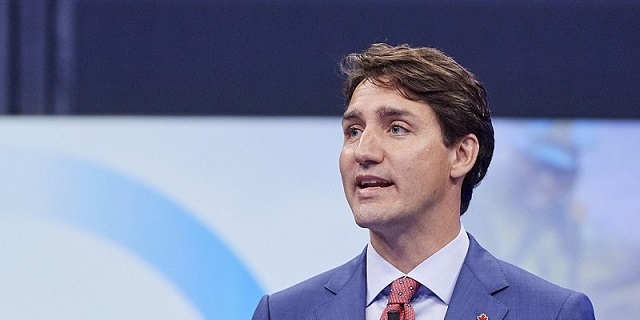Business
Ignore Ottawa’s talking points—Canada is a highly indebted country

From the Fraser Institute
By Jake Fuss
Canada falls 21 positions in international rankings after switching from net debt to gross debt, the largest change by far of any country.
The Trudeau government has claimed that Canada “continues to have an enviable fiscal and debt position relative to international peers” because we have the lowest net debt-to-GDP ratio in the G7. But this is misleading. In reality, Canada is actually a highly indebted country relative to our international peers.
The government’s claim originates from the International Monetary Fund (IMF), which notes that Canada has the lowest level of net debt (as a share of its economy) among G7 countries including Germany, Italy, Japan, France, the United Kingdom and the United States. But this specific measure of debt subtracts financial assets from total government debt.
Here’s why that’s a problem.
Again, when calculating net debt, you subtract financial assets because you assume those assets could be used to offset debt. The glaring problem here is that Canada’s financial assets include the assets of Canada Pension Plan (CPP) and Quebec Pension Plan (QPP), which substantially reduce Canada’s net debt. Indeed, according to the latest data from Statistics Canada, there were net assets of $716.7 billion in the combined CPP and QPP as of Dec. 31, 2023.
But the assets of the CPP and QPP are used for payments to existing and future retirees and can’t be used to offset government debt without compromising the ability of the CPP and QPP to provide benefits to retirees. So, Canada having the lowest net debt-to-GDP in the G7 doesn’t mean much when CPP and QPP assets are incorrectly used to make us look less indebted than we actually are.
Thankfully, there’s a much more accurate way to measure of Canada’s indebtedness—gross debt-to-GDP. Gross debt, according to the IMF, includes all “liabilities that require future payment of interest and/or principal by the debtor to the creditor.” And extending the analysis to include a broader group of advanced countries provides a more accurate assessment of Canada’s comparative indebtedness.
According to a new study, among 32 industrialized countries, Canada slides from the 5th-lowest debt ranking when net debt is measured to 26th when gross debt is used. Further, Canada’s gross debt exceeds the total size of the national economy by nearly 5 percentage points. In other words, Canada falls 21 positions in international rankings after switching from net debt to gross debt, the largest change by far of any country.
The consequences of fiscal imprudence are clear. Just like households, governments must pay interest on debt. In 2024, Canada’s federal debt interest costs are expected to eclipse $54.0 billion—equal to the entire amount of revenue the government collects from the Goods and Services Tax (GST). And debt must be repaid by future generations of Canadians through tax increases or reduction in services.
When the Trudeau government claims that Canada is in an enviable position relative to our peers on government indebtedness, it is misleading Canadians. The data clearly show that Canada is among the most indebted advanced economies in the world. That’s not something to boast about.
Author:
Automotive
Federal government should swiftly axe foolish EV mandate

From the Fraser Institute
Two recent events exemplify the fundamental irrationality that is Canada’s electric vehicle (EV) policy.
First, the Carney government re-committed to Justin Trudeau’s EV transition mandate that by 2035 all (that’s 100 per cent) of new car sales in Canada consist of “zero emission vehicles” including battery EVs, plug-in hybrid EVs and fuel-cell powered vehicles (which are virtually non-existent in today’s market). This policy has been a foolish idea since inception. The mass of car-buyers in Canada showed little desire to buy them in 2022, when the government announced the plan, and they still don’t want them.
Second, President Trump’s “Big Beautiful” budget bill has slashed taxpayer subsidies for buying new and used EVs, ended federal support for EV charging stations, and limited the ability of states to use fuel standards to force EVs onto the sales lot. Of course, Canada should not craft policy to simply match U.S. policy, but in light of policy changes south of the border Canadian policymakers would be wise to give their own EV policies a rethink.
And in this case, a rethink—that is, scrapping Ottawa’s mandate—would only benefit most Canadians. Indeed, most Canadians disapprove of the mandate; most do not want to buy EVs; most can’t afford to buy EVs (which are more expensive than traditional internal combustion vehicles and more expensive to insure and repair); and if they do manage to swing the cost of an EV, most will likely find it difficult to find public charging stations.
Also, consider this. Globally, the mining sector likely lacks the ability to keep up with the supply of metals needed to produce EVs and satisfy government mandates like we have in Canada, potentially further driving up production costs and ultimately sticker prices.
Finally, if you’re worried about losing the climate and environmental benefits of an EV transition, you should, well, not worry that much. The benefits of vehicle electrification for climate/environmental risk reduction have been oversold. In some circumstances EVs can help reduce GHG emissions—in others, they can make them worse. It depends on the fuel used to generate electricity used to charge them. And EVs have environmental negatives of their own—their fancy tires cause a lot of fine particulate pollution, one of the more harmful types of air pollution that can affect our health. And when they burst into flames (which they do with disturbing regularity) they spew toxic metals and plastics into the air with abandon.
So, to sum up in point form. Prime Minister Carney’s government has re-upped its commitment to the Trudeau-era 2035 EV mandate even while Canadians have shown for years that most don’t want to buy them. EVs don’t provide meaningful environmental benefits. They represent the worst of public policy (picking winning or losing technologies in mass markets). They are unjust (tax-robbing people who can’t afford them to subsidize those who can). And taxpayer-funded “investments” in EVs and EV-battery technology will likely be wasted in light of the diminishing U.S. market for Canadian EV tech.
If ever there was a policy so justifiably axed on its failed merits, it’s Ottawa’s EV mandate. Hopefully, the pragmatists we’ve heard much about since Carney’s election victory will acknowledge EV reality.
Business
Prime minister can make good on campaign promise by reforming Canada Health Act

From the Fraser Institute
While running for the job of leading the country, Prime Minister Carney promised to defend the Canada Health Act (CHA) and build a health-care system Canadians can be proud of. Unfortunately, to have any hope of accomplishing the latter promise, he must break the former and reform the CHA.
As long as Ottawa upholds and maintains the CHA in its current form, Canadians will not have a timely, accessible and high-quality universal health-care system they can be proud of.
Consider for a moment the remarkably poor state of health care in Canada today. According to international comparisons of universal health-care systems, Canadians endure some of the lowest access to physicians, medical technologies and hospital beds in the developed world, and wait in queues for health care that routinely rank among the longest in the developed world. This is all happening despite Canadians paying for one of the developed world’s most expensive universal-access health-care systems.
None of this is new. Canada’s poor ranking in the availability of services—despite high spending—reaches back at least two decades. And wait times for health care have nearly tripled since the early 1990s. Back then, in 1993, Canadians could expect to wait 9.3 weeks for medical treatment after GP referral compared to 30 weeks in 2024.
But fortunately, we can find the solutions to our health-care woes in other countries such as Germany, Switzerland, the Netherlands and Australia, which all provide more timely access to quality universal care. Every one of these countries requires patient cost-sharing for physician and hospital services, and allows private competition in the delivery of universally accessible services with money following patients to hospitals and surgical clinics. And all these countries allow private purchases of health care, as this reduces the burden on the publicly-funded system and creates a valuable pressure valve for it.
And this brings us back to the CHA, which contains the federal government’s requirements for provincial policymaking. To receive their full federal cash transfers for health care from Ottawa (totalling nearly $55 billion in 2025/26) provinces must abide by CHA rules and regulations.
And therein lies the rub—the CHA expressly disallows requiring patients to share the cost of treatment while the CHA’s often vaguely defined terms and conditions have been used by federal governments to discourage a larger role for the private sector in the delivery of health-care services.
Clearly, it’s time for Ottawa’s approach to reflect a more contemporary understanding of how to structure a truly world-class universal health-care system.
Prime Minister Carney can begin by learning from the federal government’s own welfare reforms in the 1990s, which reduced federal transfers and allowed provinces more flexibility with policymaking. The resulting period of provincial policy innovation reduced welfare dependency and government spending on social assistance (i.e. savings for taxpayers). When Ottawa stepped back and allowed the provinces to vary policy to their unique circumstances, Canadians got improved outcomes for fewer dollars.
We need that same approach for health care today, and it begins with the federal government reforming the CHA to expressly allow provinces the ability to explore alternate policy approaches, while maintaining the foundational principles of universality.
Next, the Carney government should either hold cash transfers for health care constant (in nominal terms), reduce them or eliminate them entirely with a concordant reduction in federal taxes. By reducing (or eliminating) the pool of cash tied to the strings of the CHA, provinces would have greater freedom to pursue reform policies they consider to be in the best interests of their residents without federal intervention.
After more than four decades of effectively mandating failing health policy, it’s high time to remove ambiguity and minimize uncertainty—and the potential for politically motivated interpretations—in the CHA. If Prime Minister Carney wants Canadians to finally have a world-class health-care system then can be proud of, he should allow the provinces to choose their own set of universal health-care policies. The first step is to fix, rather than defend, the 40-year-old legislation holding the provinces back.
-

 International2 days ago
International2 days agoChicago suburb purchases childhood home of Pope Leo XIV
-

 Daily Caller2 days ago
Daily Caller2 days agoBlackouts Coming If America Continues With Biden-Era Green Frenzy, Trump Admin Warns
-

 Daily Caller2 days ago
Daily Caller2 days ago‘I Know How These People Operate’: Fmr CIA Officer Calls BS On FBI’s New Epstein Intel
-

 National1 day ago
National1 day agoLiberal ‘Project Fear’ A Longer Con
-

 Censorship Industrial Complex23 hours ago
Censorship Industrial Complex23 hours agoCanadian pro-freedom group sounds alarm over Liberal plans to revive internet censorship bill
-

 Crime23 hours ago
Crime23 hours agoTrump supporters cry foul after DOJ memo buries the Epstein sex trafficking scandal
-

 Daily Caller22 hours ago
Daily Caller22 hours agoTrump Issues Order To End Green Energy Gravy Train, Cites National Security
-

 Daily Caller15 hours ago
Daily Caller15 hours agoUSAID Quietly Sent Thousands Of Viruses To Chinese Military-Linked Biolab








